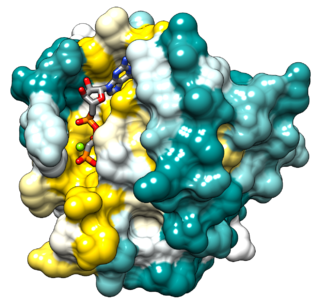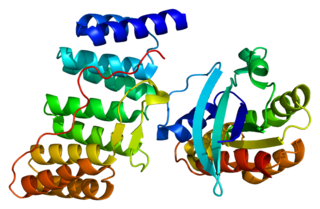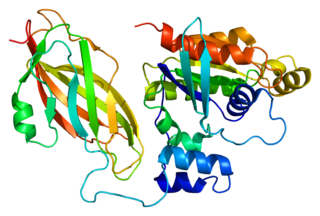Related Research Articles

Ras, from "Rat sarcoma virus", is a family of related proteins that are expressed in all animal cell lineages and organs. All Ras protein family members belong to a class of protein called small GTPase, and are involved in transmitting signals within cells. Ras is the prototypical member of the Ras superfamily of proteins, which are all related in three-dimensional structure and regulate diverse cell behaviours.

Guanine nucleotide exchange factors (GEFs) are proteins or protein domains that activate monomeric GTPases by stimulating the release of guanosine diphosphate (GDP) to allow binding of guanosine triphosphate (GTP). A variety of unrelated structural domains have been shown to exhibit guanine nucleotide exchange activity. Some GEFs can activate multiple GTPases while others are specific to a single GTPase.
The Rho family of GTPases is a family of small signaling G proteins, and is a subfamily of the Ras superfamily. The members of the Rho GTPase family have been shown to regulate many aspects of intracellular actin dynamics, and are found in all eukaryotic kingdoms, including yeasts and some plants. Three members of the family have been studied in detail: Cdc42, Rac1, and RhoA. All G proteins are "molecular switches", and Rho proteins play a role in organelle development, cytoskeletal dynamics, cell movement, and other common cellular functions.

Ras homolog gene family, member B, also known as RHOB, is a protein which in humans is encoded by the RHOB gene.

Zinc finger and BTB domain-containing protein 16 is a protein that in humans is encoded by the ZBTB16 gene.

Ras-related C3 botulinum toxin substrate 3 (Rac3) is a G protein that in humans is encoded by the RAC3 gene. It is an important component of intracellular signalling pathways. Rac3 is a member of the Rac subfamily of the Rho family of small G proteins. Members of this superfamily appear to regulate a diverse array of cellular events, including the control of cell growth, cytoskeletal reorganization, and the activation of protein kinases.

Rac2 is a small signaling G protein, and is a member of the Rac subfamily of the family Rho family of GTPases. It is encoded by the gene RAC2.

Mannose-6-phosphate receptor binding protein 1 (M6PRBP1) is a protein which in humans is encoded by the M6PRBP1 gene. Its gene product, as well as the gene itself, is commonly known as TIP47.

Chimerin 2 (beta-chimaerin) is a protein that in humans is encoded by the CHN2 gene.

RhoG is a small monomeric GTP-binding protein, and is an important component of many intracellular signalling pathways. It is a member of the Rac subfamily of the Rho family of small G proteins and is encoded by the gene RHOG.

Rho GTPase-activating protein 4 is an enzyme that in humans is encoded by the ARHGAP4 gene. It has been shown to regulate cell motility and axonal outgrowth in vitro.

Rho GTPase-activating protein 32 is a protein that in humans is encoded by the RICS gene. RICS has two known isoforms, RICS that are expressed primarily at neurite growth cones, and at the post synaptic membranes, and PX-RICS which is more widely expressed in the endoplasmic reticulum, Golgi apparatus and endosomes. The only known domain of the RICS is the RhoGAP domain, whilst PX-RICS has an additional Phox homology and SH3 domain.

TBC1 domain family member 3E/3F is a protein that in humans is encoded by the TBC1D3F gene.

Rho-related BTB domain-containing protein 2 is a protein that in humans is encoded by the RHOBTB2 gene.

Rho-related BTB domain-containing protein 3 is a protein that in humans is encoded by the RHOBTB3 gene.

Rho-related BTB domain-containing protein 1 is a protein that in humans is encoded by the RHOBTB1 gene.
Coronin is an actin binding protein which also interacts with microtubules and in some cell types is associated with phagocytosis. Coronin proteins are expressed in a large number of eukaryotic organisms from yeast to humans.

The BTB/POZ domain is a common structural domain contained within some proteins.

ABR, RhoGEF and GTPase activating protein is a protein that in humans is encoded by the ABR gene.

Ras-related protein Rab-2B is a protein that in humans is encoded by the RAB2B gene.
References
- 1 2 3 Bush J, Franek K, Cardelli J (December 1993). "Cloning and characterization of seven novel Dictyostelium discoideum rac-related genes belonging to the rho family of GTPases". Gene. 136 (1–2): 61–8. doi:10.1016/0378-1119(93)90448-C. PMID 8294042.
- 1 2 3 Rivero F, Dislich H, Glöckner G, Noegel AA (March 2001). "The Dictyostelium discoideum family of Rho-related proteins". Nucleic Acids Res. 29 (5): 1068–79. doi:10.1093/nar/29.5.1068. PMC 29714 . PMID 11222756.
- ↑ Zollman S, Godt D, Privé GG, Couderc JL, Laski FA (October 1994). "The BTB domain, found primarily in zinc finger proteins, defines an evolutionarily conserved family that includes several developmentally regulated genes in Drosophila". Proc. Natl. Acad. Sci. U.S.A. 91 (22): 10717–21. Bibcode:1994PNAS...9110717Z. doi: 10.1073/pnas.91.22.10717 . PMC 45093 . PMID 7938017.
- ↑ Ahmad KF, Engel CK, Privé GG (October 1998). "Crystal structure of the BTB domain from PLZF". Proc. Natl. Acad. Sci. U.S.A. 95 (21): 12123–8. Bibcode:1998PNAS...9512123A. doi: 10.1073/pnas.95.21.12123 . PMC 22795 . PMID 9770450.
- 1 2 Ramos S, Khademi F, Somesh BP, Rivero F (October 2002). "Genomic organization and expression profile of the small GTPases of the RhoBTB family in human and mouse". Gene. 298 (2): 147–57. doi:10.1016/S0378-1119(02)00980-0. PMID 12426103.
- ↑ Aspenström P, Fransson A, Saras J (January 2004). "Rho GTPases have diverse effects on the organization of the actin filament system". Biochem. J. 377 (Pt 2): 327–37. doi:10.1042/BJ20031041. PMC 1223866 . PMID 14521508.
- ↑ Espinosa EJ, Calero M, Sridevi K, Pfeffer SR (May 2009). "RhoBTB3: A Rho GTPase-family ATPase required for endosome to Golgi transport". Cell. 137 (5): 938–48. doi:10.1016/j.cell.2009.03.043. PMC 2801561 . PMID 19490898.